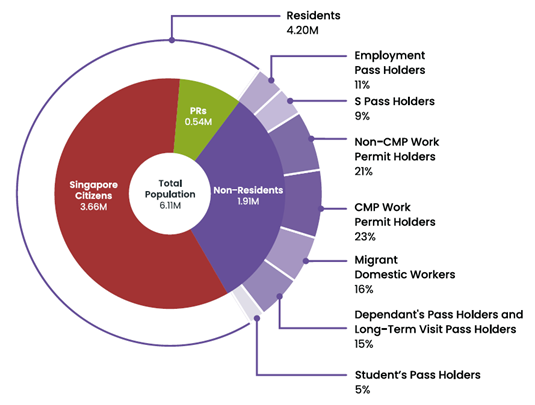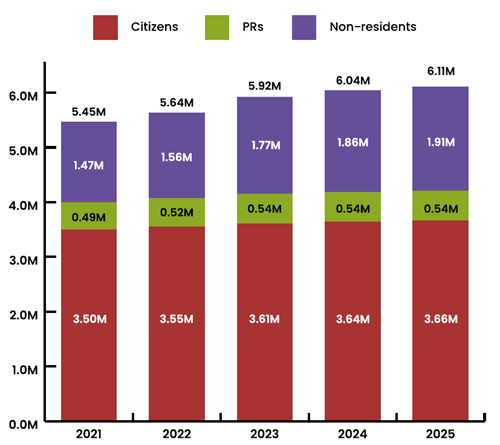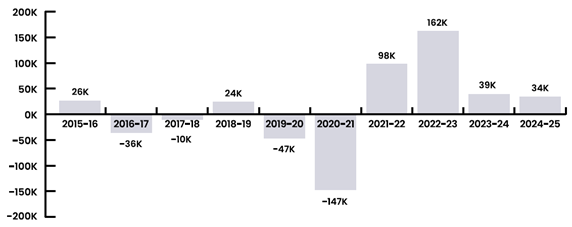Overall Population

Singapore’s total population stood at 6.11 million as at June 2025 (Diagram 1), a 1.2% increase from June 2024. This increase was mainly due to the growth in the non-resident population. The annualised population growth rate of 1.5% over the past five years (2020-2025) was higher than the 0.5% over the preceding five-year period (2015-2020), mostly due to an increase in the number of Work Permit Holders in the Construction sector to support key infrastructure projects such as Changi Terminal 5 and the ramping up of housing supply.
Diagram 1: Total population, as at June 2025[1]

Source: Department of Statistics, Ministry of Manpower
Figures may not sum up due to rounding.
The citizen population increased by 0.7% (from 3.64 million to 3.66 million),
while the Permanent Resident (PR) population remained stable at 0.54 million
in June 2025 (Chart 1).
Chart 1: Total population by residency status, as at June[2]

Source: Department of Statistics
Figures may not sum up due to rounding.
The Non-Resident (NR) population is diverse, and its size and composition fluctuate depending on our economic and social needs. Today, the foreign workforce makes up about two-thirds of the NR population, while the remaining one-third comprises mainly Migrant Domestic Workers (MDWs), dependants, and students.
As at June 2025, the NR population stood at 1.91 million, an increase of 2.7% from June 2024. The increase in the NR population came primarily from Work Permit Holders, followed by MDWs. The pace of foreign employment growth in Singapore remained stable from June 2024 to June 2025, compared to June 2023 to June 2024 (Chart 2).
Chart 2: Change in foreign employment, as at June[3]

Source: Ministry of Manpower
These figures are from the Population in Brief 2025 publication, which provides key updates and trends on Singapore’s population.
[1] Singapore residents comprise SCs and PRs.
Work Permit Holders are semi-skilled foreign workers from approved source countries. Some work in the Construction, Marine Shipyard and Process (CMP) sectors (e.g. construction workers), and others work in non-CMP sectors (e.g. Services, Manufacturing).
S Pass Holders are skilled foreign workers (Associate Professionals and Technicians). The monthly qualifying salary for an S Pass is $3,300 for applicants at age 23. This increases progressively with age, up to $4,800 at age 45 and above. A higher qualifying salary applies for the Financial Services sector.
Employment Pass Holders are foreign professionals, managers and executives. The monthly qualifying salary for an Employment Pass is $5,600 for applicants at age 23. This increases progressively with age, up to $10,700 at age 45 and above. A higher qualifying salary applies for the Financial Services sector.
Dependant’s Pass Holders and Long-Term Visit Pass Holders are mostly dependants of SCs, and Work Pass Holders.
[2] The basic count and profile of the population are based on a person’s place of usual residence i.e. de jure concept. Therefore, citizens or PRs who have a registered foreign address or have been overseas continuously for 12 months or more prior to the reference date (i.e. June each year) are not counted as part of our citizen and PR population.
[3] To provide a clearer picture of foreign workforce growth related to economic sectors, MDWs are excluded from the figures due to the distinct nature of their employment. Unlike other sectors where foreign workers contribute directly to industries such as Construction, Manufacturing and Services, MDWs work in households, performing domestic tasks.

